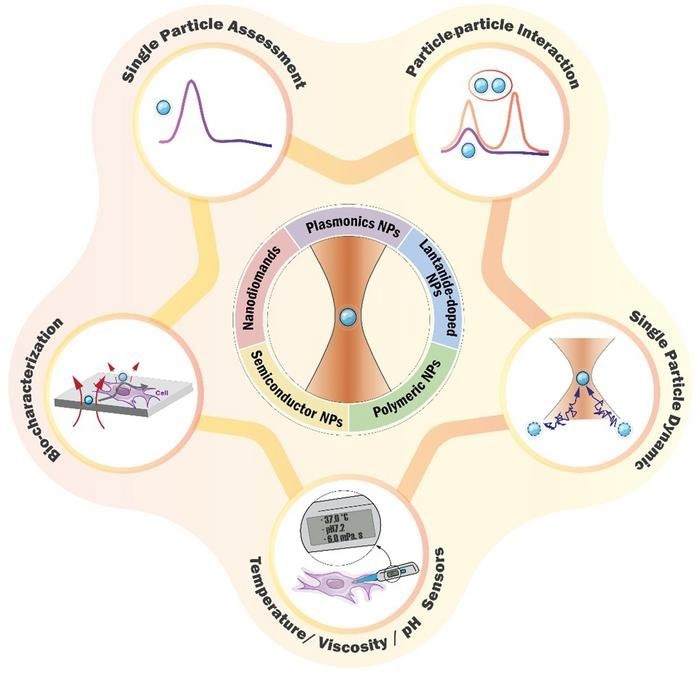Recent research published in Opto-Electronic Science provides a comprehensive review of the fundamentals and applications of optically trapped optical nanoparticles.
 Optical Trapping Of Optical Nanoparticles And Their Applications. Image Credit: Opto-Electronic Science.
Optical Trapping Of Optical Nanoparticles And Their Applications. Image Credit: Opto-Electronic Science.
The use of optical nanoparticles extends beyond enabling optical imaging across various systems, spanning from cells to microelectronics, to serving as remarkably sensitive remote sensors. Recent breakthroughs showcase the effectiveness of optical tweezers in isolating and controlling individual optical nanoparticles, paving the way for precise single-particle scanning and sensing.
As this field rapidly expands, it is imperative to consolidate current achievements, discerning the ideal systems and experimental configurations needed for specific applications.
Optical nanoparticles are categorized into five families based on different materials and their optical properties: plasmonic nanoparticles, lanthanide-doped nanoparticles, polymeric nanoparticles, semiconductor nanoparticles, and nanodiamonds. The main advances and applications for each case within these families are discussed.
Plasmonic nanoparticles have larger polarizability and high light-to-heat conversion efficiency, requiring a critical selection of trapping wavelength. The study of particle-particle interaction and temperature sensing are typical applications based on the luminescence properties of the optically trapped plasmonic nanoparticles. Such investigations are accomplished by analyzing the radiation absorbed, scattered, or emitted by nanoparticles.
Lanthanide-doped nanoparticles have narrow emission bands, long fluorescence lifetimes, and temperature-sensitive emission intensity. In the review, the researchers focus on the reported achievement of cell temperature sensing using single optically trapped lanthanide-doped nanoparticles.
The structural properties of the host of lanthanide-doped nanoparticles allow these particles to rotate. The rotation velocity depends on the medium viscosity for a fixed laser power. This property is utilized to measure intracellular viscosity, as demonstrated by the research.
Furthermore, appropriate surface functionalization of lanthanide-doped nanoparticles allows for their application in chemical sensing.
Dyes are incorporated into the polymeric nanoparticles to make them luminescent and easy to track within the optical trap. In the study, a summary of the exploration of single nanoparticle dynamics and the characterization of biological samples by leveraging the capability to track particle luminescence is provided.
This indicates the abundant potential of combining optical trapping with fluorescence or scanning microscopy and enables thorough comprehension of optical and mechanical interaction between trapping laser and optical particles.
Semiconductor nanoparticles have garnered significant interest due to their unique photoluminescence characteristics, which include adjustable emission, reduced vulnerability to photobleaching, elevated quantum yields, and robust chemical stability.
This review encapsulates studies exploring the utilization of optical tweezers in enhancing the luminescent traits of individual semiconductor nanoparticles. Additionally, it compiles research concerning the employment of semiconductor particles as focused excitation sources for cellular imaging purposes.
The fluorescence of nanodiamonds is attributed to point defects in the diamond structure, referred to as color centers. Bibliographic research indicates a limited number of reports on the optical trapping of nanodiamonds.
The initial report on the subject demonstrated that a single nanodiamond could function as a magnetic field sensor. Subsequently, an optically trapped nanodiamond is also demonstrated to operate as a cellular thermometer.
Utilizing optical trapping in conjunction with colloidal optical nanoparticles is explored for a range of applications. Despite the considerable potential of optical tweezers for single nanoparticle studies, this field is still in its early stages.
The majority of works emphasize applications rather than addressing gaps in knowledge. Several issues remain unresolved, including a precise formula describing optical forces, uncertain spatial resolution, potential sensing bias, and more. The review concludes by outlining the challenges encountered in the optical trapping of nanoparticles, aiming to stimulate ongoing research on principles, techniques, equipment, and applications in this field.
Journal Reference:
Zhang, F. C., et al. (2023). Optical trapping of optical nanoparticles: Fundamentals and applications. Opto-Electronic Science. /doi/10.29026/oes.2023.230019.